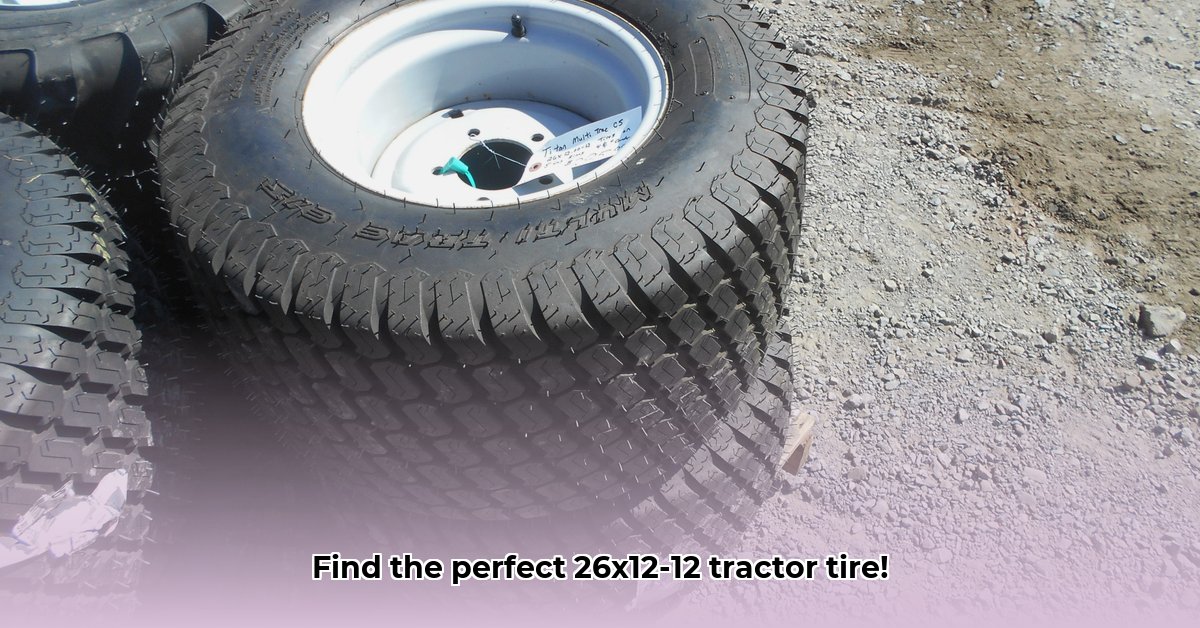
Choosing the right tires for your tractor is crucial for efficiency, longevity, and safety. This comprehensive guide focuses on 26x12-12 tractor tires, helping you navigate the selection process and make an informed decision. We'll cover technical specifications, buying advice, maintenance tips, and sustainability considerations. For more information on inner tubes, check out this resource.
Decoding 26x12-12 Tractor Tire Specifications
The numbers "26x12-12" represent the tire's diameter, width, and rim diameter. Understanding these dimensions is crucial for proper fit and performance. However, size is only one factor. Several key specifications significantly impact a tire's suitability:
Key Tire Specifications Explained
Load Capacity (in pounds): This crucial specification indicates the maximum weight a tire can safely carry. Always consult your tractor's manual to ensure you don't exceed the recommended load. Overloading can lead to catastrophic tire failure. Isn't it essential to prioritize safety above all else?
Tread Depth (in inches): This measures the depth of the grooves in the tire's tread. Deeper tread offers superior grip, especially in muddy or soft soil, but generally wears out faster. Shallower tread is better for hard surfaces, providing longer lifespan but potentially less traction. What's the right balance for your typical terrain?
Tire Construction (R1, R2, R3, R4, etc.): These designations indicate the tire's internal structure and its suitability for specific tasks. R1 tires are known for maximum traction, while R4 tires are designed for high load capacities and durability. Understanding these differences is key to choosing the right tire for your application. Are R1 tires the best choice for frequent mud work?
Choosing the Right 26x12-12 Tractor Tires: A Comprehensive Guide
Selecting the perfect 26x12-12 tire requires careful consideration of several factors:
Terrain: The type of soil significantly impacts tire choice. Deep, aggressive tread patterns excel in muddy fields, whereas shallower treads are ideal for hard surfaces. Does your work primarily involve soft or hard ground?
Usage: Heavy-duty hauling requires tires with high load capacity for safety and durability. Lighter applications allow for tires with lower load ratings, potentially reducing costs. What type of work will your tractor be primarily doing?
Budget: Tire prices vary significantly. Higher-quality tires might cost more upfront, but their extended lifespan can offset this initial expense. How does initial cost balance out with the tire's lifespan?
Manufacturer Reputation: Research different tire manufacturers, reading reviews and comparing warranties to gauge reliability and customer satisfaction. Is a well-established brand worth the premium?
Key Features Comparison: Making an Informed Decision
While a comprehensive comparison of all available 26x12-12 tires is impractical without detailed manufacturer data, the table below highlights what to look for in key features:
| Feature | Considerations | Importance |
|---|---|---|
| Load Capacity | Check your tractor's manual; select tires meeting or exceeding the recommended capacity. | Prevents tire failure, ensures safety. Overloading can cause serious damage and is never recommended. |
| Tread Depth | Deep for mud; shallower for hard surfaces. Consider the balance between grip and longevity. | Impacts grip and longevity. Deeper treads offer better grip in challenging conditions but wear down faster. |
| Construction Type | R1 for traction, R4 for heavy loads. Consider your typical work and terrain types. | Different construction types offer unique balances of load capacity, traction, and durability. |
| Tread Pattern | Aggressive pattern for mud, smooth for paved surfaces. | The pattern influences self-cleaning, grip, and overall performance across different terrain types. |
| Price | Factor in both the initial cost and the expected lifespan to determine overall cost of ownership. | Balance up-front costs with long-term costs and the potential for premature wear and replacement needs. |
Maintaining Your 26x12-12 Tractor Tires: Essential Tips
Regular tire maintenance is paramount for lengthening their lifespan and ensuring safety:
Regular Pressure Checks: Maintain the manufacturer's recommended inflation pressure. Underinflation increases wear and reduces fuel efficiency; overinflation damages sidewalls. (Always use a reliable pressure gauge.)
Tire Rotation: Rotate tires periodically for even wear, preventing premature replacement.
Visual Inspections: Regularly check for cuts, punctures, or excessive wear, addressing small issues before they become large problems.
Proper Storage: When not in use, store tires in a cool, dry location away from sunlight and extreme temperatures.
Key Takeaways: Three Pivotal Points for Choosing the Right Tires
- Matching Needs to Spec: The ideal 26x12-12 tire perfectly aligns with your tractor's intended workload and the soil conditions of your working environment.
- Understanding Ply Ratings: Higher ply ratings (e.g., 6-ply, 8-ply) provide greater load capacity and durability but may sacrifice ride comfort. Four-ply tires often suffice for light-duty applications.
- Prioritizing Maintenance: Regular tire maintenance, including inflation checks and rotation, significantly extends tire lifespan and enhances operational safety.
By following this guide and considering these key factors, you can confidently select the best 26x12-12 tractor tires for your needs, ensuring optimal performance and longevity. Remember, the right tires are a significant investment in your tractor's productivity and your own safety.